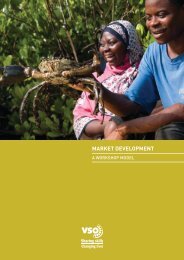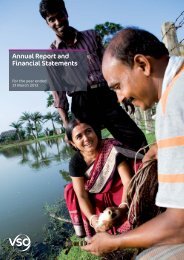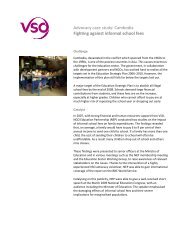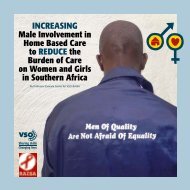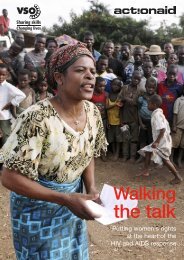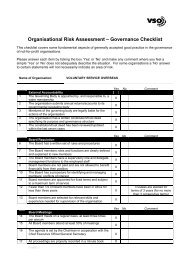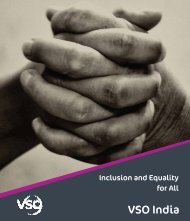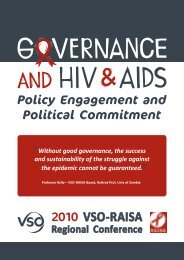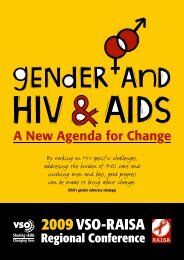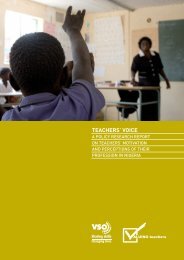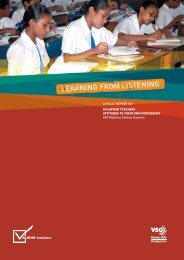Teachers for All â GCE policy briefing (566KB) - VSO
Teachers for All â GCE policy briefing (566KB) - VSO
Teachers for All â GCE policy briefing (566KB) - VSO
You also want an ePaper? Increase the reach of your titles
YUMPU automatically turns print PDFs into web optimized ePapers that Google loves.
(EFA) goals 7 demand even greater ef<strong>for</strong>ts than the MDGs. At present, the MDG framework hastended to reduce the education focus of donors to universal primary education and gender parity(in primary and secondary education – a goal that rich countries committed themselves to helppoor countries achieve by 2005, but failed abysmally), limiting governments’ ef<strong>for</strong>ts to engage inthe fuller EFA agenda.Most poor countries’ governments are fully committed to achieving the EFA goals, and some havedrafted detailed and highly credible plans in consultation with teachers’ unions, civil societyorganisations or coalitions and other education stakeholders. Yet despite donor commitments tofinance all credible EFA plans, many countries’ plans remain chronically under-funded, as donorsrepeatedly fail to deliver the urgently needed funds. As a result, governments are revising theirambitions, and plans are being scaled down to fit available resources. Consequently, sufficientnumbers of teachers cannot be hired and millions of children will remain excluded come 2015 –unless urgent action is taken now. The US$10 billion per year in aid <strong>for</strong> education that donors lastyear promised will be delivered by 2010, needs to be delivered now. Governments cannot wait until2010 to hire the teachers they need.To help governments and donors address these problems, each chapter of this report closes with asummary of recommendations drawn from the discussion and analysis in the chapter and from theliterature reviewed therein. It is hoped that Global Campaign <strong>for</strong> Education national coalitions,teachers’ unions, NGOs, child rights organisations and other members and allies of the GlobalCampaign <strong>for</strong> Education will be able to adapt these recommendations <strong>for</strong> use in their discussionswith governments and donors. The recommendations are reproduced here, arranged according tothe themes of the chapters to follow:Recommendations on teacher shortage and supply• The MDGs will not be achieved without universal access to quality basic services provided bystrong public systems. This will require a massive investment by poor country governments anddonors in rebuilding the public sector, including investing in recruitment, training and salaries<strong>for</strong> 14–22.5 million extra teachers (as well as millions of health workers and other public sectorworkers), and an end to user fees (Oxfam, 2005:1).• Governments and donors must work together to reduce pupil–teacher ratios to 40:1 (whichshould be seen as a maximum in all regions of a country, not an average, nor a target to whichpupil–teacher ratios should be raised). Classes with high proportions of first generationlearners should be smaller than 40:1 to allow teachers to give such children the extra attentionthey need – especially where children speak a different language to their teachers. Double andtriple shifting should be avoided unless different teachers are used <strong>for</strong> different shifts.• Lower secondary education should be expanded to at least 35% enrolment to ensure adequatenumbers of potential teacher trainees.• Governments must put in place adequate monitoring systems <strong>for</strong> measuring the impact of theHIV & AIDS pandemic on education. This should include gender disaggregated data. Inparticular, education management in<strong>for</strong>mation systems (EMIS) need to be strengthened inorder to capture data on teacher absenteeism and mortality as a result of AIDS. As a minimum,governments should protect teachers by developing an HIV & AIDS workplace <strong>policy</strong> in orderthat bouts of absenteeism, either <strong>for</strong> caring or <strong>for</strong> sickness, are <strong>for</strong>mally recognised andrespected.7 The Education For <strong>All</strong> (EFA) goals, (agreed in April 2000 by heads of state, ministers of education, heads of UNagencies, among others) committed governments to achieving the following goals by 2015:• expand early childhood care and education• ensure all children, particularly girls, complete free and compulsory, good quality primary education• ensure equal access to learning and life-skills training <strong>for</strong> young people and adults• achieve a 50% improvement in adult literacy rates• achieve gender equality in primary and secondary education• improve the quality of education – especially in literacy, numeracy and essential life skills.6



